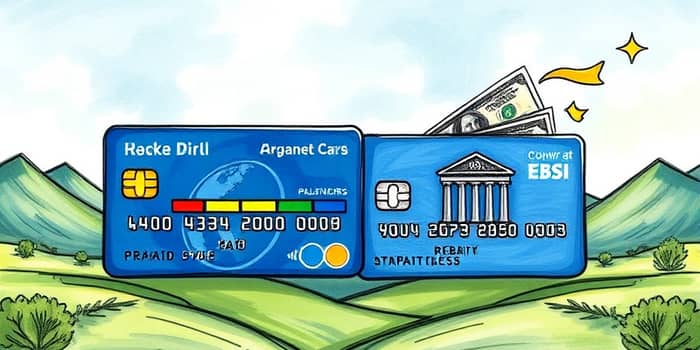Prepaid and debit cards offer convenient access to funds without cash. Understanding their core features and practical differences can help you choose the right tool to manage your finances.
Definition and Overview
A prepaid card is a payment solution that allows you to spend only what has been loaded onto it. It operates independently of a bank account and can be funded via cash, check, direct deposit, or electronic transfer. Because it is not tied to a traditional checking or savings account, users do not need to pass a credit check to obtain one.
In contrast, a debit card is linked directly to your checking or savings account at a financial institution. Any purchase or ATM withdrawal draws funds immediately from your existing balance. Some debit accounts may allow overdrafts, permitting you to spend beyond your balance at the cost of an overdraft fee.
How Each Card Works
- Prepaid cards are purchased at retail locations or online, then loaded with funds. Once you spend those funds, you must reload to continue using the card.
- Debit cards are issued when you open a checking account. Transactions draw directly from your account balance, and reloading is automatic as you deposit funds into your linked account.
- Prepaid users can reload via cash deposit points, bank transfers, or direct deposit, while debit users simply transfer money to their account as usual.
- ATM withdrawals are available on both card types, though fees and network access may vary by provider.
Key Similarities and Differences
Both prepaid and debit cards enable electronic payments and ATM access without extending credit. Neither builds credit history, and both come with spending controls based on available or loaded funds. However, their relationships to financial institutions, fee structures, and risk profiles differ significantly.
Fee Structures and Costs
Understanding fees is crucial when selecting between prepaid and debit cards. Prepaid cards typically include a variety of charges that can quickly add up if you’re not careful about reloading habits and usage.
- Purchase fee: One-time fee up to $9.95, though many providers waive this for online purchases.
- Monthly maintenance fee: Ranges from $5 to $9.95 per month.
- ATM withdrawal fee: Usually $2 to $3, plus potential terminal fees.
- Reload fee: Anywhere between $2 to $5 per transaction, or a percentage of the amount.
- Inactivity/dormancy fee: May apply if the card is unused for several months.
Debit cards generally have fewer fees. You might encounter ATM fees if you use machines outside your network, and some banks charge a monthly account fee that can often be waived by meeting a minimum balance requirement.
Security and Fraud Protection
When it comes to safety, prepaid and debit cards differ in how they expose you to potential loss. A lost or stolen prepaid card only jeopardizes the balance loaded onto that card, making it safer for controlling your funds when traveling or supervising teen spending.
Debit cards, being linked directly to your checking account, can pose a greater risk if compromised. Unauthorized charges may remove funds from your account, and while banks often offer dispute resolution, the recovery process can be time-consuming and stressful.
Use Cases and Practical Applications
Prepaid cards serve a diverse range of use cases:
- Ideal for budgeting and travel—you control exactly how much is available.
- Suitable for unbanked individuals or those unable to pass credit checks.
- Popular for payroll distribution in some industries to avoid paper checks.
- Useful for gifting, allowances, or one-time transactions.
Debit cards are more appropriate for those who maintain regular banking relationships, rely on direct deposits and automated bill payments, and appreciate automatic access to deposited funds without manual reloads. They also support features such as online bill pay, mobile banking integrations, and overdraft protection options.
Pros and Cons Summary
- Prepaid Pros: No credit check, no traditional bank account required, limited risk of overdraft, tight spending control.
- Prepaid Cons: higher and frequent fee structures, limited acceptance for deposits or holds, no credit-building opportunities.
- Debit Pros: Fewer fees, broader acceptance, seamless banking services.
- Debit Cons: Potential overdraft fees, direct exposure to main account, may require minimum balances.
Making the Right Choice
Selecting between a prepaid card and a debit card hinges on your financial goals, banking status, and spending habits. If you seek complete spending control with no banking ties, prepaid cards can provide a straightforward solution for specific use cases. Conversely, if you maintain a checking account and desire easy access to a broader suite of banking services, a debit card may be the most efficient and cost-effective option.
Before making a decision, review the fee schedule carefully, consider your typical transaction types, and prioritize the features that matter most to your lifestyle, such as ATM accessibility, mobile app support, and fraud protection. Armed with knowledge about each card’s mechanics, you can confidently manage your funds and avoid unexpected charges.
By aligning your choice with your spending patterns—whether you value tight budgeting controls or integrated banking services—you can leverage the right plastic tool to streamline payments and maintain financial peace of mind.
References
- https://www.consumerfinance.gov/ask-cfpb/how-are-prepaid-cards-debit-cards-and-credit-cards-different-en-433/
- https://www.bankrate.com/credit-cards/building-credit/prepaid-vs-debit-cards/
- https://wise.com/us/blog/prepaid-vs-debit-card
- https://www.airwallex.com/us/blog/what-is-a-prepaid-card
- https://www.nerdwallet.com/article/banking/how-do-prepaid-debit-cards-work
- https://www.chime.com/blog/chime-debit-card-vs-prepaid-card/
- https://www.experian.com/blogs/ask-experian/what-is-a-prepaid-credit-card/










